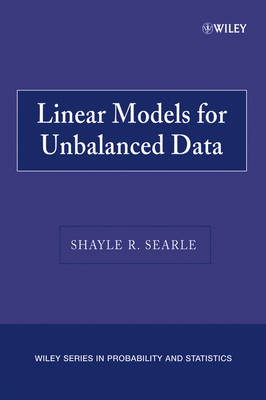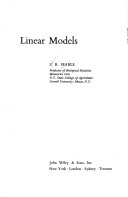Probability & Mathematical Statistics S.
3 total works
Variance Components
by Shayle R. Searle, George Casella, and Charles E McCulloch
Published 27 March 1992
This text presents a broad coverage of variance components. It deals with the estimation of variance components and the prediction of realized but unobservable values of random variables in analysis of variance models and in binary and discrete data. The authors begin with an introduction to the subject, which details more complicated types of data appearing in subsequent chapters. All the major methods of estimating components are discussed at length, including ANOVA, ML, REML, and Bayes. Topics covered include history, analysis of variance estimation, maximum likelihood (ML) estimation, prediction in mixed models, Bayes estimation and hierarchical models, categorical data, covariance components and minimum norm estimation, dispersion-mean model, kurtosis and fourth moments.
WILEY-INTERSCIENCE PAPERBACK SERIES The Wiley-Interscience Paperback Series consists of selected books that have been made more accessible to consumers in an effort to increase global appeal and general circulation. With these new unabridged softcover volumes, Wiley hopes to extend the lives of these works by making them available to future generations of statisticians, mathematicians, and scientists. "[This book] provides an excellent discussion of the methodology and interpretation of linear models analysis of unbalanced data (data having unequal numbers of observations in the subclasses), generally without matrices?the author does an excellent job of emphasizing the more practical nature of the book. Highly recommended for graduate and undergraduate libraries." a?"Choice "This is a very comprehensive text, aimed at both students studying linear-model theory and practicing statisticians who require an understanding of the model-fitting procedures incorporated in statistical packages?This book should be considered as a text for college courses as it provides a clearly presented and thorough treatment of linear models.
It will also be useful to any practicing statistician who has to analyze unbalanced data, perhaps arising from surveys, and wishes to understand the output from model-fitting procedures and the discrepancies in analysis from one recognized package to another." a?"Biometrics This newly available and affordably priced paperback version of Linear Models for Unbalanced Data offers a presentation of the fundamentals of linear statistical models unique in its total devotion to unbalanced data and its emphasis on the up-to-date cell means model approach to linear models for unbalanced data. Topic coverage includes cell means models, 1-way classification, nested classifications, 2-way classification with some-cells-empty data, models with covariables, matrix algebra and quadratic forms, linear model theory, and much more.
It will also be useful to any practicing statistician who has to analyze unbalanced data, perhaps arising from surveys, and wishes to understand the output from model-fitting procedures and the discrepancies in analysis from one recognized package to another." a?"Biometrics This newly available and affordably priced paperback version of Linear Models for Unbalanced Data offers a presentation of the fundamentals of linear statistical models unique in its total devotion to unbalanced data and its emphasis on the up-to-date cell means model approach to linear models for unbalanced data. Topic coverage includes cell means models, 1-way classification, nested classifications, 2-way classification with some-cells-empty data, models with covariables, matrix algebra and quadratic forms, linear model theory, and much more.
The main objective of this text is to describe general procedures of estimation and hypothesis testing for linear statistical models and shows their application for unbalanced data (i.e., unequal-subclass-numbers data) to certain specific models that often arise in research and survey work. In addition, three chapters are devoted to methods and results for estimating variance components, particularly from unbalanced data. Exercises are provided throughout the chapter that will enable the reader to practice and become familiar with the techniques described.


